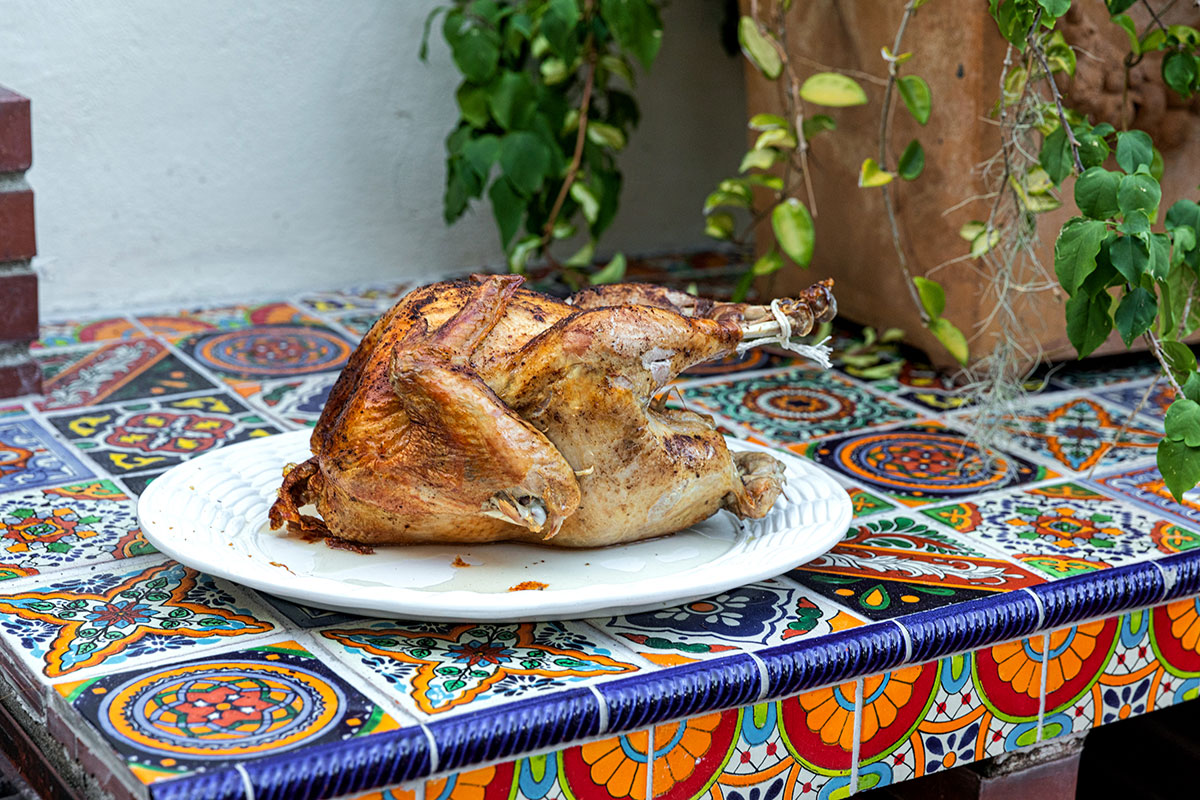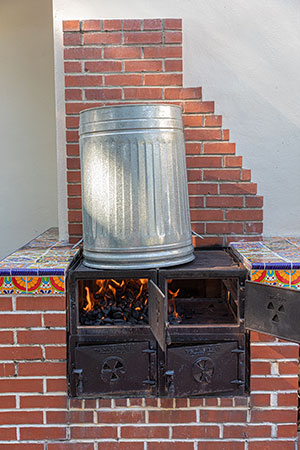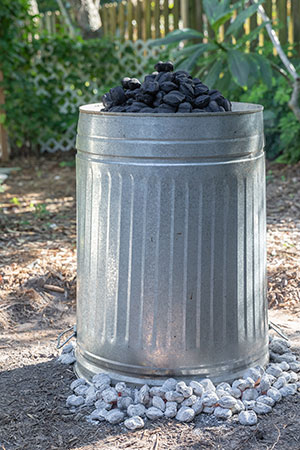Smokin' Hot Turkey

Ensure your Thanksgiving bird is cooked evenly throughout for succulent results with the trash-can method
BY BARBARA REID

Thanksgiving is once again upon us — a time for family and friends to gather and give thanks for the many blessings throughout the year. And while many look forward to a Rockwellian event replete with mountains of scrumptious fare, most home chefs can attest to at least a few stories of Thanksgiving disasters.
Along with the plethora of side dishes and desserts to orchestrate, there’s the perennial question of how to cook the perfect turkey. In the days leading up to the big day, the Butterball Turkey Talk-Line keeps a-buzzing with burning questions from concerned cooks. How does one avoid the breast meat ending up as dry as a bone while the dark meat remains raw? Will salmonella be the star of the show rather than the turkey?
It turns out the answers lie more in understanding avian anatomy than gastronomic wizardry. A bird with both light and dark meat presents its own set of challenges as breast meat cooks much faster than dark, so by the time the temperature is deemed safe for human consumption, the breast is already overdone. So what’s a chef to do? Fear not. This month we’re going to reveal a fun and foolproof way to ensure your turkey is juicy and your guests are amazed.
BRINING
One step to remedying dryness is to brine the bird ahead of time. Brining is a process by which the bird is soaked for several hours in a saline solution of broth, salt, sugar and seasoning. Not only does this add moisture to the meat, but it also enhances the flavor.
COOKING
Next comes the question of how to cook the bird. Smoking, roasting, direct and indirect grilling and frying have all been touted as tried-and-true methods, with frying being the most hazardous. One fun cooking method involves a beer can, whereby a chicken is impaled on a partially full can of beer and placed on the grill. Take this one step further, and you have our recipe of the month.

TRASH CAN TURKEY
I first saw this showstopper performed at the home of Vero Beach resident Colleen Liebert. An accomplished chef in her own right, Liebert had invited friends to share in her Thanksgiving festivities, this time relinquishing her apron to trusted friend Larry Timmerman. He has been cooking turkeys this way for many years and swears by a recipe from Steven Raichlen’s cookbook, BBQ USA, wherein Raichlen claims it to be almost impossible to overcook turkey breast using this method.
PROCEDURE
A brined and well-seasoned turkey is speared atop a stake stuck into the ground and covered with a trash can. Glowing coals are then placed around and atop the trash can, and roughly one and a half hours later, you have a bird that is “meltingly tender and ineffably succulent,” to quote Raichlen.
This method not only frees up the oven for all the side dishes but also cooks the meat more quickly, thus providing a few hours of entertainment for the male contingent in your group — men who will happily gather around a smoldering trash can and drink beer. We hope you’ll give it a try. Happy Thanksgiving!
Recipe

1 12-pound turkey, fresh or defrosted
Olive oil for brushing
3 tablespoons poultry seasoning of your choice
For the brine:
1 cup kosher salt
½ cup brown sugar
1-3 sprigs rosemary
1-3 sprigs thyme
2-4 bay leaves
4 quart (32-ounce) cartons vegetable broth
½ cup brown sugar
1 cup kosher salt
1 tablespoon crushed dried rosemary
1 tablespoon dried sage
1 tablespoon dried thyme
1 tablespoon dried savory
For the setup:
A meat thermometer
Heavy-duty gloves
Shovel
1 metal stake, 1 x 20 inches
Heavy-duty aluminum foil
Bricks for anchoring foil
20 pounds charcoal
Disposable aluminum pan to catch the drippings —
and the bird if it falls.
New aluminum trash can, rinsed out with soapy water.
LARRY’S TIPS
• Truss the legs of the bird to hold them in place and ensure the meat is cooked evenly.
• Stuff the neck cavity with aluminum foil to prevent the bird from sliding down the stake.
• Make sure the stake is not too tall, otherwise the bird will touch the top of the can and burn.
• Because the trash can takes about 20 minutes to heat up, Larry prefers to preheat it with hot coals before placing it over the bird. This is where the heavy-duty gloves come in handy. This also helps to burn off any chemicals in the metal.
• Don’t limit your repertoire; Larry says he has cooked both partridge and pheasant this way.

Two days before Thanksgiving, combine all the brining ingredients in a large stockpot and bring to a boil. Stir well to dissolve the salt and sugar, then remove from heat and cool to room temperature. Stir in one gallon of iced water and pour into a brining bag or container that will fit in the refrigerator.
Remove innards and wash and dry the turkey. Place breast down in the brine, making sure the cavity is filled and the turkey is completely submerged. Place in the refrigerator for 12-16 hours. (Do not overdo the brining or the texture will resemble that of luncheon meat.)
The day before you plan to cook the bird, remove it from the brine and pat dry with paper towels. Brush the skin with oil and rub with seasoning, making sure to fill the neck and cavity. Cover and refrigerate overnight.
Make a four-foot circle on the ground with aluminum foil. (Note: if placing on grass, make sure it’s grass you don’t mind killing). Anchor the foil with bricks and place the dripping pan in the center. Hammer the stake in the middle of the pan into the ground, leaving 16 inches sticking out.
With the neck end up, lower the turkey onto the stake. Place the trash can over the turkey. Shovel one-third of the coals on top and the remainder around the sides of the trash can. Light the coals. Some recipes call for lighting the coals on a grill and shoveling them onto and around the trash can when hot. Either way, when the coals are ready, cook the bird for 1½-2 hours depending on the size or until a thermometer inserted into the thick part of the thigh reads 180 degrees.
To remove the turkey, shovel the coals from the top of the trash can and, wearing heavy-duty gloves, remove the trash can and lift the bird from the stake. Transfer to a carving platter, cover and let rest for 15-20 minutes.
LARRY’S ROAD-KILL STORY
“I belong to a fishing and hunting club, and one spring I was driving there for some early-season trout fishing. As I was traveling along Route 9, I saw there was a dead hen turkey on the side of the road. It didn’t look too flat.
“I circled back and checked it out, and I could tell it had flown into a car and had likely broken its neck. I picked it up, walked back to my Land Rover and loaded it up. My two dogs were very excited.
“I cleaned and plucked it and found it was a perfect specimen! I called a brave couple we know and invited them to the club for a road kill dinner. I got out my trash can, cooked it and served it with fresh fiddlehead ferns and baked grits. Best road kill any of us had ever had.”
